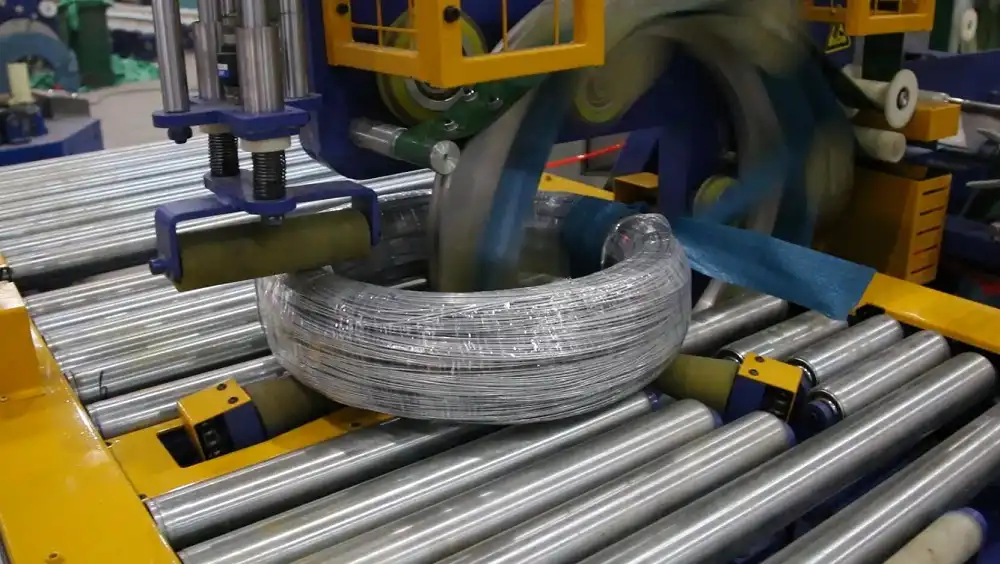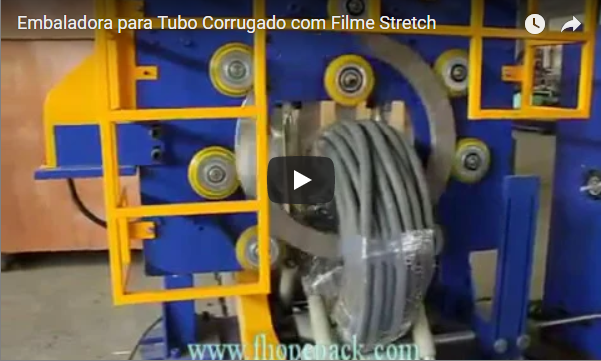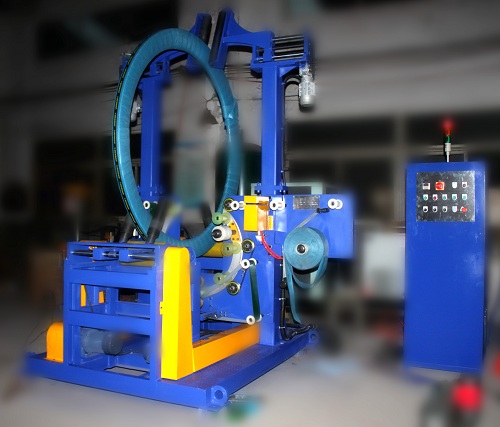Mastering PET Belt Coil Packaging: A Fabricator's Guide to Automated Wrapping Machines
Handling and packaging large, heavy coils of PET (Polyethylene Terephthalate) strapping belt presents unique challenges on the factory floor. Manual wrapping is often slow, inconsistent, and labor-intensive. This is where automated PET belt coil wrapping machines step in, offering a streamlined, efficient, and protective packaging solution. This guide delves into the technical aspects, real-world benefits, and considerations for implementing these essential machines in your operation.
1. The Challenge: Why Manual PET Coil Wrapping Falls Short
Before diving into the machinery, let's understand the limitations of traditional manual wrapping for PET belt coils:
- Inconsistency: Achieving uniform tension and overlap manually is difficult, potentially leading to unstable loads or wasted film.
- Labor Costs: Manual wrapping requires dedicated personnel, adding significant labor costs, especially in high-volume operations.
- Speed Limitations: Manual processes inherently limit throughput, creating bottlenecks in the packaging line.
- Ergonomics and Safety: Maneuvering heavy stretch film rolls around large coils can be physically demanding and pose safety risks.
- Product Protection: Inconsistent wraps may not offer adequate protection against dust, moisture, and handling damage during transit and storage.
Automated solutions directly address these pain points, providing a compelling case for investment.
2. Under the Hood: How PET Belt Coil Wrapping Machines Operate
Most dedicated PET belt coil wrappers utilize an orbital wrapping mechanism. Here’s a breakdown of the typical process and key components:
- Loading: The PET belt coil is placed onto the machine's support rollers or conveyor system, positioned within the wrapping ring's path.
- Ring Rotation: A large rotating ring holds the stretch film carriage. As the ring orbits around the stationary (or sometimes slowly rotating) coil, it dispenses the film.
- Film Application: The stretch film is fed from the carriage, often through a pre-stretch unit. This unit stretches the film before application (common ratios are 150% to 300%), maximizing film yield and ensuring a tight, secure wrap.
- Coil Rotation (Optional but Common): Support rollers beneath the coil slowly rotate it, ensuring the film covers the entire surface evenly as the ring orbits.
- Film Cut and Clamp: Once the programmed number of wraps is complete, automated systems typically clamp the film, cut it, and secure the tail end to the coil (e.g., via heat seal or wipe-down mechanism).
- Unloading: The fully wrapped coil is discharged from the machine, ready for labeling, palletizing, or shipping.
Key Components:
- Wrapping Ring: The core orbital component holding the film delivery system.
- Film Carriage & Pre-stretch Unit: Holds the film roll and stretches it for optimal performance and economy.
- Support Rollers/Conveyor: Holds and often rotates the coil during wrapping.
- Control System (PLC/HMI): Programmable Logic Controller and Human-Machine Interface for setting parameters (wrap counts, tension, rotation speed) and diagnostics.
- Safety Features: Emergency stops, safety fencing, light curtains are crucial.

3. Key Specifications & Features Fabricators Need to Evaluate
Selecting the right machine requires careful consideration of your specific needs. Here are critical parameters:
- Coil Dimensions:
- Inner Diameter (ID): Minimum and Maximum
- Outer Diameter (OD): Minimum and Maximum
- Width/Height: Minimum and Maximum
- Coil Weight: Maximum capacity the machine can handle.
- Wrapping Speed: Typically measured in ring RPM or estimated coils per hour. Match this to your production throughput.
- Stretch Film:
- Film Width Compatibility (e.g., 500mm)
- Film Thickness Range
- Pre-stretch Ratio (Fixed or variable, e.g., up to 250%)
- Automation Level:
- Automatic film clamp, cut, and seal mechanisms.
- Integration capabilities with upstream and downstream conveyors.
- Automatic fault diagnosis.
- Control & Customization:
- Adjustable wrapping tension.
- Variable ring and roller speeds.
- Programmable wrapping patterns (e.g., reinforcing wraps at edges).
- Power & Air Requirements: Ensure compatibility with your facility's utilities.
4. A Fabricator's Perspective: Real-World Gains from Automation
From experience on the shop floor, the transition to an automated PET belt coil wrapper delivers tangible results:
- Boosted Throughput: We've seen operations dramatically reduce packaging cycle times, moving coils from production to shipping much faster. Consistent, automated wrapping easily outpaces manual efforts, eliminating bottlenecks.
- Superior Load Integrity: The machine applies film with consistent tension and precise overlap, creating a stable, tightly bound coil. This significantly reduces the risk of product damage during handling and transportation – fewer customer complaints, less waste.
- Significant Labor Savings: Automating this process frees up valuable personnel for other tasks. While maintenance and oversight are needed, the reduction in direct manual wrapping labor provides a clear return on investment.
- Optimized Film Consumption: The pre-stretch function is key. Stretching the film means you use less material per coil compared to manual wrapping, leading to direct cost savings and reduced environmental impact. Many fabricators report film usage reductions of 30-50%.
- Improved Workplace Safety: Removing the need for operators to manually walk heavy film rolls around coils drastically cuts down on potential strains, trips, and other ergonomic injuries.
5. Choosing the Right Machine: Matching Technology to Your Needs
The ideal PET belt coil wrapping machine depends on your operational context:
- Production Volume: Low-volume users might consider semi-automatic models, while high-volume continuous operations require fully automated systems integrated into the production line.
- Coil Variability: If you handle a wide range of coil sizes and weights, look for machines with broad specification ranges and easy adjustment capabilities.
- Budget: Costs vary significantly based on automation level, speed, and features. Calculate the potential ROI based on labor savings, material reduction, and throughput gains.
- Space and Layout: Ensure you have adequate floor space for the machine and any associated infeed/outfeed conveyors.
- Integration: Plan how the wrapper will connect with existing material handling systems (cranes, forklifts, conveyors).
6. Seamless Integration: Making the Wrapper Part of Your Flow
Implementing a new wrapping machine effectively often involves more than just placing it on the floor. Consider:
- Material Flow: How will coils arrive at the machine and depart once wrapped? Conveyor systems, AGVs, or forklift access need planning.
- Operator Training: Ensure personnel are properly trained on operation, parameter setting, film loading, and basic troubleshooting.
- Maintenance Schedule: Like any industrial equipment, regular preventative maintenance is crucial for longevity and reliable performance.

7. Conclusion: Investing in Efficiency and Protection
The PET belt coil wrapping machine is far more than just a packaging device; it's a strategic investment in operational efficiency, product protection, cost reduction, and worker safety. By carefully evaluating your specific requirements against the technical capabilities and features available, you can select and implement a solution that streamlines your PET belt packaging process, ensuring your product reaches its destination securely and cost-effectively. This automated approach is rapidly becoming the standard in modern manufacturing and logistics operations dealing with PET strapping coils.
For further information on coil packing solutions:
Coil Packing Machine Solutions
Contact us for specific inquiries:
info@fhopepack.com






